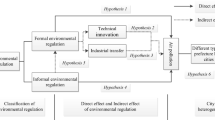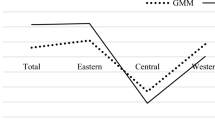Abstract
This paper makes a first empirical attempt at estimating the effects of environmental regulation on air pollution, total factor productivity (TFP), and factor structure based on a quasi-natural experiment method using a novel dataset of 216 prefectural-level cities during the years 1998–2016 in China. Specifically, we are focused on the policy impact of the listed key environmental protection (KEP) prefectures which subject to more stringent environmental regulations than non-KEP prefectures. Our empirical results show that the PM2.5 intensity, environmental performance, and TFP of the KEP prefectures are significantly lower than the non-KEP prefectures. The environmental policy also affects the factor structure of KEP cites. Heterogeneity analysis indicates that the policy significantly lowered the PM2.5 for central and western cities while it is unclear for eastern cities. Our findings also document that the policy effects are unclear in the long term. Various robustness checks confirm the internal validity. These estimation results are instructive to the policymakers. We suggest that the central government should measure the effectiveness of policies within 5 years of policy formulation. Governments at all levels should make targeted adjustments based on actual impact effects. The central government should be granted local governments more speaking power and flexibility in policy implementation when formulating environmental regulatory policies. Otherwise, the central government also needs to improve the communication medium with provincial governments.




Similar content being viewed by others
Notes
Toward an Environmentally Sustainable Future: Country Environmental Analysis of the People’s Republic of China was published by the Asian Development Bank (ADB) and Ministry of Ecological and Environment of the People’s Republic of China in 2012.
Some heavy industry sectors, such as steel smelting processing and chemical industry, these sectors may produce more pollutants than light industry sectors.
Air Quality Standards published (GB 3095—2012) by the Ministry of Ecology and Environment of the People’s Republic of China and General Administration of Quality Supervision, Inspection and Quarantine of People’s Republic of China. The 35 μg/m3 of annual PM2.5 intensity is the dividing standard between the primary and secondary cities. We average the PM2.5 intensity within 1998–2016.
References
Brunnermeier SB, Cohen MA (2003) Determinants of environmental innovation in US manufacturing industries. J Environ Econ Manag 45(2):278–293. https://doi.org/10.1016/S0095-0696(02)00058-X
Charnes A, Cooper WW, Rhodes E (1978) Measuring the efficiency of decision making units. Eur J Oper Res 2(6):429–444. https://doi.org/10.1016/0377-2217(78)90138-8
Chung YH, Färe R, Grosskopf S (1997) Productivity and undesirable outputs: a directional distance function approach. J Environ Manag 51(3):229–240. https://doi.org/10.1006/jema.1997.0146
Dogan E, Ozturk I (2017) The influence of renewable and non-renewable energy consumption and real income on CO2 emissions in the USA: evidence from structural break tests. Environ Sci Pollut Res 24(11):10846–10854. https://doi.org/10.1007/s11356-017-8786-y
Dogan E, Seker F (2016) Determinants of CO2 emissions in the European Union: the role of renewable and non-renewable energy. Renew Energy 94:429–439. https://doi.org/10.1016/j.renene.2016.03.078
Dogan E, Turkekul B (2016) CO2 emissions, real output, energy consumption, trade, urbanization and financial development: testing the EKC hypothesis for the USA. Environ Sci Pollut Res 23(2):1203–1213. https://doi.org/10.1007/s11356-015-5323-8
Färe R, Grosskopf S, Lindgren B, Roos P (1994) Productivity developments in Swedish hospitals: a Malmquist output index approach. In: Data envelopment analysis: theory, methodology, and applications. Springer, Dordrecht, pp 253–272
Hamamoto M (2006) Environmental regulation and the productivity of Japanese manufacturing industries. Resour Energy Econ 28(4):299–312. https://doi.org/10.1016/j.reseneeco.2005.11.001
Hanna R (2010) US environmental regulation and FDI: evidence from a panel of US-based multinational firms. Am Econ J Appl Econ 2(3):158–189. https://doi.org/10.1257/app.2.3.158
Huang J, Yu Y, Ma C (2018) Energy efficiency convergence in China: catch-up, lock-in and regulatory uniformity. Environ Resour Econ 70(1):107–130. https://doi.org/10.1007/s10640-017-0112-0
Jorgenson DW, Wilcoxen PJ (1990) Environmental regulation and US economic growth. RAND J Econ:314–340. https://doi.org/10.2307/2555426
Liu M, Shadbegian R, Zhang B (2017) Does environmental regulation affect labor demand in China? Evidence from the textile printing and dyeing industry. J Environ Econ Manag 86:277–294. https://doi.org/10.1016/j.jeem.2017.05.008
Malmquist S (1953) Index numbers and indifference curves. Trabajos de Estatistica 4(1):209–242
Moledina AA, Coggins JS, Polasky S, Costello C (2003) Dynamic environmental policy with strategic firms: prices versus quantities. J Environ Econ Manag 45(2):356–376. https://doi.org/10.1016/S0095-0696(02)00055-4
Moutinho V, Madaleno M, Inglesi-Lotz R, Dogan E (2018) Factors affecting CO2 emissions in top countries on renewable energies: a LMDI decomposition application. Renew Sust Energ Rev 90:605–622. https://doi.org/10.1016/j.rser.2018.02.009
Murty MN, Kumar S (2003) Win–win opportunities and environmental regulation: testing of porter hypothesis for Indian manufacturing industries. J Environ Manag 67(2):139–144. https://doi.org/10.1016/S0301-4797(02)00203-7
Porter ME (1991) America’s green strategy. Scientific American, 264, p. 168
Porter ME, Van der Linde C (1995) Toward a new conception of the environment-competitiveness relationship. J Econ Perspect 9(4):97–118. https://doi.org/10.1257/jep.9.4.97
Shi X, Xu Z (2018) Environmental regulation and firm exports: evidence from the eleventh five-year plan in China. J Environ Econ Manag 89:187–200. https://doi.org/10.1016/j.jeem.2018.03.003
Tanguay GA, Rajaonson J, Lefebvre JF, Lanoie P (2010) Measuring the sustainability of cities: an analysis of the use of local indicators. Ecol Indic 10(2):407–418. https://doi.org/10.1016/j.ecolind.2009.07.013
Tone K (2001) A slacks-based measure of efficiency in data envelopment analysis. Eur J Oper Res 130(3):498–509. https://doi.org/10.1016/S0377-2217(99)00407-5
Van Rooij B (2006) Implementation of Chinese environmental law: regular enforcement and political campaigns. Dev Chang 37(1):57–74. https://doi.org/10.1111/j.0012-155X.2006.00469.x
Xepapadeas A, de Zeeuw A (1999) Environmental policy and competitiveness: the Porter hypothesis and the composition of capital. J Environ Econ Manag 37(2):165–182. https://doi.org/10.1006/jeem.1998.1061
Zhou P, Poh KL, Ang BW (2007) A non-radial DEA approach to measuring environmental performance. Eur J Oper Res 178(1):1–9. https://doi.org/10.1016/j.ejor.2006.04.038
Funding
We thank the financial support provided by the National Key R&D Program of China (2018YFC0213600), National Natural Science Foundation of China (91746112, 71822402), and Research Center on Low-carbon Economy for Guangzhou Region. This research also supported by National Natural Science Foundation of China (71532013, 71903068) and China Postdoctoral Science Foundation (2019M653301).
Author information
Authors and Affiliations
Corresponding author
Additional information
Responsible editor: Eyup Dogan
Publisher’s note
Springer Nature remains neutral with regard to jurisdictional claims in published maps and institutional affiliations.
Highlights
• Total factor productivity of 216 Chinese prefectural-level cities is estimated.
• The effects of environmental regulation on air pollution, productivity, and factor structure are investigated using DID and DDD estimators.
• The mechanism and heterogeneity analysis are fully considered.
• Empirical results are robust to alternative measures of air pollution, alternative the year of implementing KEP policy, etc.
Appendices
Appendix 1. Grouping data
The grouping data of prefectures in this paper can be downloaded at the following website: https://github.com/zhaokeke-cn/paper-grouping-data.
Appendix 2. Long-term effects of the KEP policy
Rights and permissions
About this article
Cite this article
Zhang, N., Zhao, K. & Yu, Y. The effect of environmental regulation on air pollution, productivity, and factor structure: a quasi-natural experiment evidence from China. Environ Sci Pollut Res 27, 20392–20409 (2020). https://doi.org/10.1007/s11356-020-08462-4
Received:
Accepted:
Published:
Issue Date:
DOI: https://doi.org/10.1007/s11356-020-08462-4
Keywords
- Environmental regulation
- Air pollution
- Difference-in-differences
- Total factor productivity
- Key environmental protection policy




